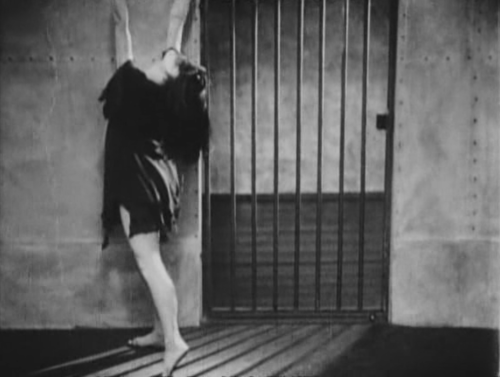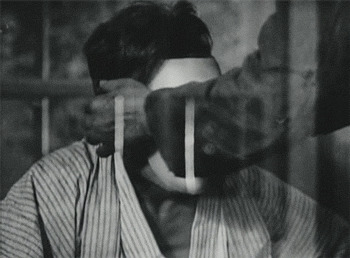Eu adoro receber recomendações de
filmes – em especial quando estes filmes são recomendados por pessoas cultas.
Eu confio no gosto da Nora Fiore (mais conhecida como The Nitrate Diva) em
relação a filmes. Ela é uma jovem da geração millennial que, além de inteligente
e talentosa, ama tanto clássicos quanto eu. Por isso eu adicionei “Uma Página
de Loucura” (1926) à minha lista de filmes assim que ela o recomendou neste post.
I love movie recommendations – especially when they come from
knowledgeable people. I really rely on Nora Fiore’s (aka The Nitrate Diva’s)
taste on film. She is a wise and talented millennial who shares my passion for
classics. That’s why I added “A Page of Madness” (1926) to my watch list when
she recommended the film in this post.
Enquanto a chuva cai lá fora, os pacientes
em um hospício são acompanhados apenas por seus delírios. Uma garota dança sem
parar em sua cela, imaginando que é uma bailarina ou uma deusa, e os trovões
são os instrumentos criando a música para sua performance. Uma mulher está
deitada no chão de sua cela, e apenas olha pra cima para ver o zelador. Mas há
muito neste olhar: o zelador e a paciente são marido e esposa. Ele quer que
ela, e todos os outros pacientes, sejam libertados daquele inferno.
While the rain falls outside, the patients inside an insane asylum are
left with their deliriums. One girl dances nonstop in her cell, imagining she
is a performer or a goddess, and the thunders are the instruments making the
music for her ballet. A woman lies on the floor of her cell, only looking up to
see the janitor. But there is a lot in this look: the janitor and the patient
are husband and wife. He wants to take her, and eventually all patients, out of
that hell.
Você percebeu que eu usei a palavra “cela”
em vez de “quarto” para me referir ao espaço que cada paciente ocupa, não? Bem,
eu tenho razões para a escolha da palavra: este é, de fato, um ambiente que
parece uma prisão. Há um portão de ferro na entrada da ala, e cada paciente é
também preso atrás de grades.
You noticed that I wrote “cell” instead of “room” to talk about the
space each patient has, didn’t you? Well, I have a reason: it is, indeed, an
environment like a prison. There is an iron gate made in the room entrance, and
each patient is also kept behind bars.
É possível ver reflexos de muitos
filmes e movimentos nesta película. A influência de Caligari é a mais óbvia: “Uma
Página de Loucura” conta uma história que se passa em um hospício, e tem muitas
sombras. Há tomadas angulosas e de cabeça para baixo. Ângulos de câmera ousados
e truques com a câmera dão origem a imagens distorcidas.
You can see many films and movements reflected in this film. The
Caligari influence is the most obvious: “A Page of Madness” is a film set in an
insane asylum, and has lots of shadows. There are angular and upside-down
shots. Unusual camera angles and wise camera tricks create distorted images.
Em muitos momentos, a edição é tão
frenética e nauseante quanto o melhor de Eisenstein. Isso acontece logo no
começo do filme. Na teoria da montagem soviética, a maneira e velocidade com
que as imagens são editadas evocam um sentimento ou ideia. Em “Uma Página de
Loucura”, a montagem nos ajuda a entrar nas mentes dos pacientes.
In many moments, the editing is as frantic and dizzying as the best
Eisenstein. This happens right in the beginning of the movie. In the Soviet
montage, the way and speed images are edited together evoke a feeling or idea.
In “A Page of Madness”, the montage actually helps us enter the patients’
minds.
Assim como “A Última Gargalhada”
(1924), de Murnau, “Uma Página de Loucura” não tem intertítulos. Algumas
pessoas podem pensar que aí está a genialidade do filme, enquanto outras podem
ficar incomodadas e confusas com a falta de explicações. Você consegue entender
perfeitamente a narrativa de “A Última Gargalhada”, mas em “Uma Página de
Loucura” muitas hipóteses podem surgir devido à ausência de intertítulos. Não
nos esqueçamos que o cinema nunca foi mudo no Japão – até os anos 1930, ele foi
narrado por artistas conhecidos como Benshi.
Just like Murnau’s “The Last Laugh” (1924), “A Page of Madness” has no
intertitles. Some people may think this is where the geniality of the film lies,
while others may be bothered and confused by the lack of explanation. If you
can understand perfectly what is going on in “The Last Laugh”, in “A Page of
Madness” many hypothesis and interpretations are originated from the lack of
intertitles. Let’s not forget that there was never a truly silent cinema in
Japan – until the 1930s, movies were narrated by artists called Benshi.
Devemos nos lembrar de que “O Gabinete
do Dr Caligari” estreou em 1920, os filmes soviéticos com edição ousada como “Greve”
e “O Encouraçado Potemkin” são, respectivamente, de 1924 e 1925, e “A Última
Gargalhada” estreou em 1924. Estes filmes chegaram ao Japão em tempo de
influenciar “Uma Página de Loucura”?
We must remember that “The Cabinet of Dr Caligari” was released in 1920,
the heavily edited Soviet movies “Strike” and “Battleship Potemkin” are,
respectively, from 1924 and 1925, and “The Last Laugh” was released in 1924. Did
all these works arrive in Japan in time to influence “A Page of Madness”?
“O Gabinete do Dr Caligari” certamente
chegou a tempo: de acordo com o IMDb, o filme estreou no Japão em 1921. “A
Última Gargalhada” foi visto cinco vezes pelo diretor Teinosuke Kinugasa, que
inclusive o classificou como seu filme favorito em uma entrevista em 1926. De
acordo com o IMDb, os filmes soviéticos só foram exibidos no Japão nos anos 60.
Kinugasa tinha outras influências em mente quando filmou “Uma Página de Loucura”.
“The Cabinet of Dr Caligari” certainly arrived in time: according to
IMDb, the film was released in Japan in 1921.”The Last Laugh” was seen five
times by director Teinosuke Kinugasa, who also cited it as his favorite film in
an interview in 1926. According to IMDb,
the Soviet films were seen in Japan only in the 1960s. Kinugasa had other
influences in mind when he was shooting “A Page of Madness”.
O mundo todo estava fazendo
experimentos nos anos 20. Nas artes, havia o Surrealismo, Dadaísmo, Art Deco e
Expressionismo. É possível ver um pouco de cada um em “Uma Página de Loucura”.
Kinugasa também tinha um grupo envolvido com vanguardas artísticas trabalhando
para ele atrás das câmeras. No circuito cinematográfico, havia muitas
discussões no Japão acerca dos filmes Impressionistas de Abel Gance e Marcel L’Herbier.
The whole world was experimenting in the 1920s. In the arts, we had
Surrealism, Dadaism, Art Deco and Expressionism. You can see a little bit of
them all in “A Page of Madness”. Kinugasa also had a group of avant-garde
lovers helping him behind the cameras. In the film circles, there was a lot of
discussing in Japan about the Impressionist works by Abel Gance and Marcel L’Herbier.
“Uma Página de Loucura” pode assustar
você, com certeza – especialmente se você tiver alguma coisa contra máscaras
sem expressão. Eu ficaria assustada se tivesse visto este filme quando era mais nova. Mas o terror real é perceber como eram – e infelizmente ainda são –
tratadas as pessoas que não se encaixam no padrão de “sanidade”.
“A Page of Madness” can scare you, sure – especially if you have
something against expressionless masks. I’d be scared if I watched this film
when I was younger. But the real horror here is realizing how badly people who
don’t follow a “sanity” pattern were – and unfortunately still are – treated.
Talvez você ame “Uma Página de Loucura”.
Talvez você o odeie. Talvez você tenha de assisti-lo muitas vezes, e a cada vez
encontrar novos significados. Mas você não poderá ficar indiferente em relação
a “Uma Página de Loucura”.
You may
love “A Page of Madness”. You may hate it. You may have to watch the movie several times and, each time, find more
meanings. But you can’t be indifferent after watching “A Page of Madness”.
This is my contribution to the Horrorathon, hosted by Maddy at Maddylovesherclassicfilms.


+hall.png)
%2B1.png)



1 comment:
This sounds awesome. I love Silent films and this seems like one to see. It will make for difficult viewing given the subject matter. Thanks for taking part. Maddy
Post a Comment